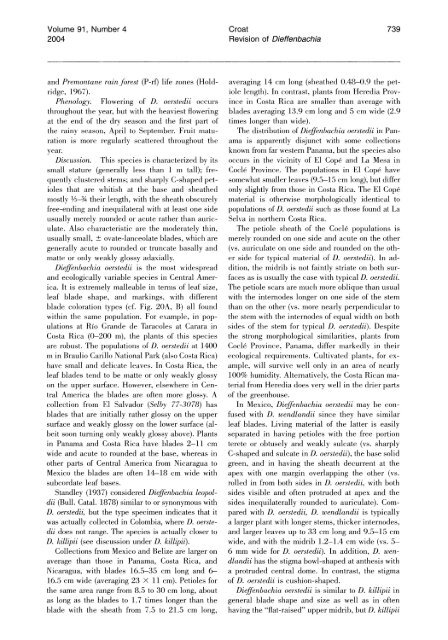l - CNCFlora
l - CNCFlora
l - CNCFlora
Create successful ePaper yourself
Turn your PDF publications into a flip-book with our unique Google optimized e-Paper software.
Volume 91, Number 4<br />
2004<br />
Croat<br />
Revision of Dieffenbachia<br />
and Prernontane rain forest (P-rf) life zones (Hold- averaging 14 cm long (sheathed 0.48-0.9 the petridge,<br />
1967).<br />
iole length). In contrast, plants from Heredia Prov-<br />
Phenology. Flowering of D. oerstedii occurs ince in Costa Rica are smaller than average with<br />
throughout the year, but with the heaviest flowering blades averaging 13.9 cm long and 5 cm wide (2.9<br />
at the end of the dry season and the first part of times longer than wide).<br />
the rainy season, April to September. Fruit matu- The distribution of Dieffenbachia oerstedii in Panration<br />
is more regularly scattered throughout the ama is apparently disjunct with some collections<br />
year.<br />
known from far western Panama, but the species also<br />
Discussion. This species is characterized by its occurs in the vicinity of E1 Cope and La Mesa in<br />
small stature (generally less than 1 m tall); fre- Cocle Province. The populations in E1 Cope have<br />
quently clustered stems; and sharply C-shaped pet- somewhat smaller leaves (9.5-15 cm long), but differ<br />
ioles that are whitish at the base and sheathed only slightly from those in Costa Rica. The E1 Cope<br />
mostly 1/3_3/4 their length, with the sheath obscurely material is otherwise morphologically identical to<br />
free-ending and inequilateral with at least one side populations of DP oerstedii such as those found at La<br />
usually merely rounded or acute rather than auric- Selva in northern Costa Rica.<br />
ulate. Also characteristic are the moderately thin, The petiole sheath of the Cocle populations is<br />
usually small, + ovate-lanceolate blades, which are merely rounded on one side and acute on the other<br />
generally acute to rounded or truncate basally and (vs. auriculate on one side and rounded on the othmatte<br />
or only weakly glossy adaxially.<br />
er side for typical material of D. oerstedii). In ad-<br />
Dief77enbachia oerstedii is the most widespread dition, the midrib is not faintly striate on both surand<br />
ecologically variable species in Central Amer- faces as is usually the case with typical D. oerstedii.<br />
ica. It is extremely malleable in terms of leaf size, The petiole scars are much more oblique than usual<br />
leaf blade shape, and markings, with different with the internodes longer on one side of the stem<br />
blade coloration types (cf. Fig. 20A, B) all found than on the other (vs. more nearly perpendicular to<br />
within the same population. For example, in pop- the stem with the internodes of equal width on both<br />
ulations at Rio Grande de Taracoles at Carara in sides of the stem for typical D. oerstedii). Despite<br />
Costa Rica (0-200 m), the plants of this species the strong morphological similarities, plants from<br />
are robust. The populations of D. oerstedii at 1400 Cocle Province, Panama, differ markedly in their<br />
m in Braulio Carillo National Park (also Costa Rica) ecological requirements. Cultivated plants, for exhave<br />
small anel delivate leaves. In Costa Rica, the ample, will survive well only in an area of nearly<br />
leaf blades tend to be matte or only weakly glossy 100% humidity. Alternatively, the Costa Rican maon<br />
the upper surface. However, elsewhere in Cen- terial from Heredia does very well in the drier parts<br />
tral America the blades are often more glossy. A of the greenhouse.<br />
collection from E1 Salvador (Selby 77-3()78) has In Mexico, Dieffenbachia oerstedii may be conblades<br />
that are initially rather glossy on the upper fused with D. wendlandii since they have similar<br />
surface and weakly glossy on the lower surface (al- leaf blades. Living material of the latter is easily<br />
beit soon turning only weakly glossy above). Plants separated in having petioles with the free portion<br />
in Panama and Costa Rica have blades 2-11 cm terete or obtusely and weakly sulcate (vs. sharply<br />
wide and acute to rounded at the base, whereas in C-shaped and sulcate in D. oerstedii), the base solid<br />
other parts of Central America from Nicaragua to green, and in having the sheath decurrent at the<br />
Mexico the blades are often 14-18 cm wide with apex with one margin overlapping the other (vs.<br />
subcordate leaf bases.<br />
rolled in from both sides in D. oerstedii, with both<br />
Standley (1937) considered Dieffienbachia leopol- sides visible and often protruded at apex and the<br />
dii (Bull. Catal. 1878) similar to or synonymous with sides inequilaterally rounded to auriculate) Com-<br />
D. oerstedii, but the type specimen indicates that it pared with D. oerstedii, D. wendlandii is typically<br />
was actually collected in Colombia, where D. oerste- a larger plant with longer stems, thicker internodes,<br />
dii does not range. 'The species is actually closer to and larger leaves up to 33 cm long and 9.5-15 cm<br />
D. killipii (see discussion under D. killipii). wide, and with the midrib 1.2-1.4 cm wide (vs. 5-<br />
Collections from Mexico and Belize are larger on 6 mm wide for D. oerstedii). In addition, D. wenaverage<br />
than those in Panama, Costa Rica, and dlandii has the stigma bowl-shaped at anthesis with<br />
Nicaragua, with blades 16.5-35 cm long and 6- a protruded central dome. In contrast, the stigma<br />
16.5 cm wide (averaging 23 x 11 cm). Petioles for of D. oerstedii is cushion-shaped.<br />
the same area range from 8.5 to 30 cm long, about Diegenbachia oerstedii is similar to D. killipii in<br />
as long as the blades to 1.7 times longer than the general blade shape and size as well as in often<br />
blade with the sheath from 7.5 to 21.5 cm long,<br />
having the 66flat-raised" upper midrib, but D. killipii<br />
739

















